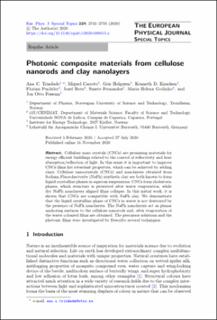| dc.contributor.author | Trindade, Ana Catarina | |
| dc.contributor.author | Carreto, Miguel | |
| dc.contributor.author | Helgesen, Geir | |
| dc.contributor.author | Knudsen, Kenneth Dahl | |
| dc.contributor.author | Puchtler, Florian | |
| dc.contributor.author | Breu, Josef | |
| dc.contributor.author | Fernandes, Susete | |
| dc.contributor.author | Godinho, Maria Helena | |
| dc.contributor.author | Fossum, Jon Otto | |
| dc.date.accessioned | 2021-01-25T18:45:01Z | |
| dc.date.available | 2021-01-25T18:45:01Z | |
| dc.date.created | 2020-11-23T10:39:21Z | |
| dc.date.issued | 2020 | |
| dc.identifier.citation | The European Physical Journal Special Topics. 2020, 229 2741-2755. | en_US |
| dc.identifier.issn | 1951-6355 | |
| dc.identifier.uri | https://hdl.handle.net/11250/2724635 | |
| dc.description.abstract | Cellulose nano crystals (CNCs) are promising materials for energy efficient buildings related to the control of reflectivity and heat absorption/reflection of light. In this sense it is important to improve CNCs films fire retardant properties, which can be achieved by adding clays. Cellulose nanocrystals (CNCs) and nanolayers obtained from Sodium Fluorohectorite (NaFh) synthetic clay are both known to form liquid crystalline phases in aqueous suspensions. CNCs form cholesteric phases, which structure is preserved after water evaporation, while dry NaFh nanolayers aligned films collapse. In this initial work, it is shown that CNCs are compatible with NaFh clay. We demonstrate that the liquid crystalline phase of CNCs in water is not destroyed by the presence of NaFh nanolayers. The NaFh nanolayers act as planar anchoring surfaces to the cellulose nanorods and, after evaporation of the water coloured films are obtained. The precursor solutions and the photonic films were investigated by Describe several techniques. | en_US |
| dc.language.iso | eng | en_US |
| dc.publisher | Springer | en_US |
| dc.rights | Navngivelse 4.0 Internasjonal | * |
| dc.rights.uri | http://creativecommons.org/licenses/by/4.0/deed.no | * |
| dc.title | Photonic composite materials from cellulose nanorods and clay nanolayers | en_US |
| dc.type | Peer reviewed | en_US |
| dc.type | Journal article | en_US |
| dc.description.version | publishedVersion | en_US |
| dc.source.pagenumber | 2741-2755 | en_US |
| dc.source.volume | 229 | en_US |
| dc.source.journal | The European Physical Journal Special Topics | en_US |
| dc.identifier.doi | 10.1140/epjst/e2020-000015-y | |
| dc.identifier.cristin | 1850926 | |
| dc.relation.project | Norges forskningsråd: 250619 | en_US |
| dc.description.localcode | Open Access This is an Open Access article distributed under the terms of the Creative Commons Attribution License (https://creativecommons.org/licenses/by/4.0), which permits unrestricted use, distribution, and reproduction in any medium, provided the original work is properly cited. | en_US |
| cristin.ispublished | true | |
| cristin.fulltext | original | |
| cristin.qualitycode | 1 | |

